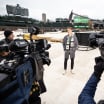The Coaches Room is a regular feature throughout the 2023-24 season by former NHL coaches and assistants who turn their critical gaze to the game and explain it through the lens of a teacher.
In this edition, Davis Payne, former coach of the St. Louis Blues and assistant with the Los Angeles Kings, Buffalo Sabres and Ottawa Senators, writes about helping players acquired at the NHL Trade Deadline adjust to their new team with limited time before the start of the Stanley Cup Playoffs.
When a player is acquired before the NHL Trade Deadline, there’s a lot of moving pieces and a lot of things coaches will do to help him fit in with his new team.
The player was traded to your team because you feel you have a chance to get into the Stanley Cup Playoffs and make a run at the Stanley Cup. How quickly everybody can get comfortable with that is one of the magical mysteries of making changes to your group at the Deadline.
It’s sort of multifaceted for the staff. You’re used to young players coming up from your minor league team, so there is a similar run down on systems for the new player(s). You don’t want to overload the player, you just want to get him comfortable with the framework of your systems and then let the player go play.
You can make those corrections as it goes, but you want to quickly establish a relationship as to how things are going to operate between you and the player. Everybody has that common goal, and it’s how quickly can you get that communication to a point where it can happen seamlessly, whether it’s in game or in practice or in teaching sessions.
If you have practice time, you’re going to detail your practice around the things that the new player or players need to learn in terms of structure to reinforce the different details of your team game.
If the schedule doesn’t allow for time to practice, that’s when video becomes really important. You need a lot of reinforcement as to doing it right with some easy correction video that shows the difference between the two.
Your veteran players become a critical piece of the puzzle in getting the new player comfortable on the ice with the reads. A lot of that is communication as the play is going on. Don’t assume anything; you have to talk each situation through. If you’re a defenseman, your partner becomes an important piece. If you’re a forward, your linemates become really important.
That constant conversation should be going on during practice and through the entire game from on-the-ice communication to getting back on the bench and talking through the shift or about the next shift, and then between periods.
You’re relying on everybody helping each other through the differences and the nuances of each team, each system, and each player combination so the player can get comfortable, add to the mix, and play his game. Your veteran guys and your leadership group also play a significant role in the player getting comfortable off the ice.
We’re a profession that routine is something we rely upon. But when you’re a new player in a new city, all the sudden you’ve got to use your GPS on your phone to get to the practice rink or the arena, and get to know where restaurants are, etc. So, how quickly can you make the new player and his family feel comfortable about where they are and the place they’ve found to live?
All these things are hurdles you’ve got to get over to be focused entirely on your performance and team performance.
Each player is different with regards to how much time it takes for that to happen because of the situation they’re coming out of and the situation they’re going into. The role they’re going to play might be different from the role they played with their former team. The player might be a potential unrestricted free agent and might have his contract status on his mind.
All these bits of unknown in a player’s mind can affect performance, and you want to get the player comfortable as quickly as possible through any of that so he isn’t worrying about it.
Another key piece is the role embracement of your entire roster. You may be trading for a top-six forward who is coming into a team that is already well-structured and has groupings of players playing together.
Now, you’re adding a piece that’s going to make your team better and the next questions are where does he fit, who does he play with and what minutes does he get? And the minutes he plays are going to impact the player who was perhaps playing those minutes prior to that.
So, you try to put players in a situation where they’re playing with players you think complement them and, perhaps, there’s a familiarity with. You saw that with the Winnipeg Jets when they acquired Tyler Toffoli from the New Jersey Devils and they immediately put him on a line with Alex Iafallo, a player he had a relationship with from earlier in his career with the Kings.
You also have to understand that when a team is playing well and the performances are consistent night in and night out, players know, “OK, I’m going to be matching up against their top lines. I’m going to be playing in offensive situations. I’m going to be getting defensive-zone draws. I’m going to be on the first power-play unit, first penalty-kill group.”
When you get your team performing, those roles are almost predetermined because you’ve been doing it over and over. It almost becomes autopilot.
When a new player is added, everybody needs to be engaged. Some players need to be ready to play more minutes and some need to be ready to play fewer minutes.
When I was with the Kings, we were in a good spot to enter the playoffs in 2014, but management thought adding more scoring would help. So, we brought in Marian Gaborik in a trade with the Columbus Blue Jackets.
It was an important move for us to put him with Anze Kopitar so that Kopitar could handle all the 200-foot responsibilities, and Marian could just go out and play his game. He played with Kopitar and Dustin Brown, two veteran guys who talked him through every situation and allowed him to understand everything that was going on.
At the same time, Justin Williams was the player who moved down and embraced a third-line role playing with Jarret Stoll and Dwight King. The amazing thing about it was Gaborik and Williams were the two players in line for the Conn Smythe Trophy as the most valuable player in the playoffs when we won the Stanley Cup. Williams won it, and deservedly so, but you could make the argument that Gaborik, who scored 14 goals in the playoffs, could have.
That’s a great example of players being put in a situation where they could play their game with veteran leadership working beside them and another player accepting a role and different responsibility and knowing the reason everybody is doing this is to have a chance to win the Stanley Cup.


















